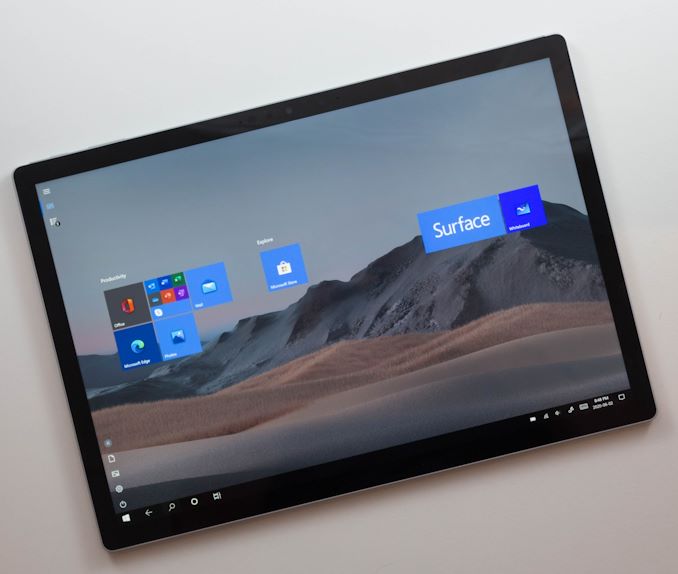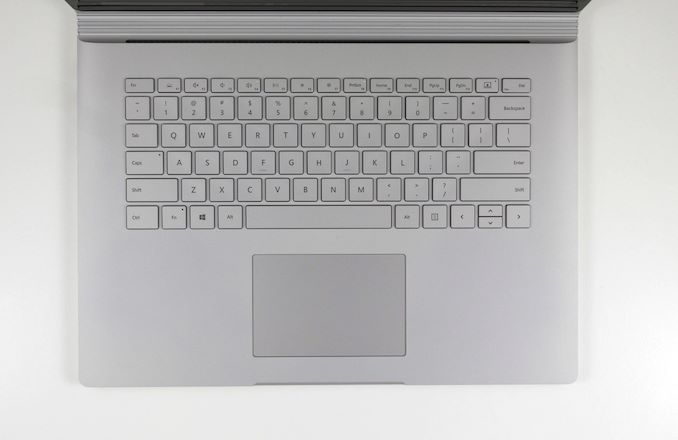The Microsoft Surface Book 3 (15-Inch) Review: A Refreshing Dip Into Ice Lake
by Brett Howse on June 3, 2020 9:00 AM ESTDesign
When Microsoft first launched the Surface lineup, the design team was very much about bringing new form factors to the PC space. The original Surface RT and Surface Pro introduced the kickstand to the convertible tablet, and with Surface Pro 3, Microsoft adopted the 3:2 aspect ratio which they have carried onto all their products since. Surface Book was a unique take on a convertible laptop, thanks to the detachable tablet, putting a dGPU in the keyboard base, and especially the dynamic fulcrum hinge which gives the Surface Book its very distinctive appearance.
But, as with all devices, there are some compromises with each design decision. For convertible devices like the Surface Book, it generally means some design trade-offs when compared to a more traditional clamshell laptop, just as how a traditional clamshell laptop gives up some of the extra functionality of a convertible.
One of the biggest things you will notice comparing the Surface Book 3 to other high-end laptops is one of the first compromises, and that is the display bezels. As the industry has moved to thinner and thinner display bezels to maximize display real estate in smaller and smaller devices, the Surface Book 3 features the same large bezels as it has always had. Since the Surface Book 3 has a detachable display for use as a tablet, some extra bezel is required as somewhere to hold on to, but even so, Microsoft has managed to shrink the bezels on other Surface products to make them a bit less obvious. Unfortunately, since the Surface Book 3 is not getting any design refresh with this update, it has lost some ground compared to the rest of the industry.
Having a detachable display also means the PC components must be behind the display. This results in a trade-off of its own, with the Surface Book being required to use Intel's 15-Watt range of processors. It's a notable distinction, as much of the competition, especially in the larger 15-inch range we are reviewing today, leverages more powerful 45-Watt SoCs. The upside for Surface Book is that this leaves a lot of thermal capacity in the keyboard base, allowing it to be outfitted with much more powerful GPU options than you would normally see in a 15-inch productivity device.
Even though the exterior is more or less unchanged from the Surface Book 2, Microsoft has still tweaked the design a bit, with an upgraded hinge offering more support. There have been some welcome changes to the detach of the tablet as well: the speed of the detach process has been improved, offering two times faster unlock on the 13-inch and three times faster unlock on the 15-inch over the outgoing model. There is also a new feature called Safe Detach, which leverages a new ability in DirectX 12 to move an active workload from the discrete GPU to the integrated GPU, allowing the tablet to be detached even when the discrete GPU is in use. Unfortunately, this does require developers to explicitly support the feature, and Microsoft offered up an example of World of Warcraft as an application which already takes advantage of this technology.
Another area that appears unchanged but got some significant upgrades is the Surface Connect port. On the Surface Book 2, the Surface Connect port, which is used for both charging and docking to the Surface Dock, had some serious limitations, particularly compared to what USB Type-C has been doing. The charging capabilities of the port were limited to 100 Watts, and the Surface Book 2 15-inch when under a very heavy load could sometimes draw slightly more than that. This would cause the battery drain while connected to power in some circumstances, such as gaming. Microsoft has beefed up the relative power pins now, and the Surface Book 3 now ships with a 127-Watt adapter, removing that issue.
The second major upgrade with the new Surface Connect port is how much data can be transferred through it. The port, which was first introduced on Surface Pro 3, was effectively a precursor to the USB-C that we know and love today, with Microsoft using a proprietary connector that combined both USB and DisplayPort into a single cable. The previous Surface Connect port carried USB 3.0 (3.2 Gen 1) and 4 lanes of DisplayPort 1.2, which limited it to 5 Gbps on the USB side, and on the display side there was enough bandwidth for a 4K@60Hz display, but only one of them.
The Surface Book 3, in turn bumps the port up to USB 3.2 Gen 2 and DisplayPort 1.4. The means that the port now carries a 10 Gbps USB connection for data, and the faster DisplayPort connection can handle dual UHD displays at 60 Hz when connected to the new Surface Dock 2. The updated connector, in turn, remains pin-compatible with the previous connector, meaning that prior docks will work, albeit without being able to run at the higher speeds the newer Surface Connect port supports. Meanwhile Microsoft still has not embraced Thunderbolt 3, so the Surface lineup remains stuck to the proprietary dock, but the new Surface Dock 2 does at least address most of the concerns over the previous version.
| Surface Connect Port Specifications | ||||
| Ver. 1 | Ver. 2 | |||
| Connector Type | 40-pin "Surflink" | 40-pin "Surflink" | ||
| USB | USB 3.x Gen 1 (5 Gbps) |
USB 3.x Gen 2 (10 Gbps) |
||
| Display | DisplayPort 1.2 4 Lanes |
DisplayPort 1.4 4 Lanes |
||
| Max Power | 100W | 127W | ||
Other than those minor design changes, the rest of the Surface Book 3 chassis is relatively unchanged from the Surface Book 2. The Surface Book continues to offer one of the best keyboards on any notebook. The trackpad is wonderfully implemented, and although some competitors have stretched the size of the trackpad, the Surface Book 3 still offers one that is generously sized. The chassis continues to be made out of a magnesium alloy, offering a fantastic feel.
The Surface Book 2 was one of the best notebooks available, and although the design is now starting to show its age, the Surface Book 3 still works well. The nature of convertible devices is that of compromise though, as they try to fill multiple roles. The Surface Book’s take, with a detachable display and dynamic fulcrum hinge continues to embrace that difference rather than do its best to hide it. For ease of use, a convertible with a 360° hinge is still less complicated, and quicker to switch modes. The 15-inch version especially is too large to use as a tablet most of the time, whereas the 13.5-inch version is a bit easier to handle in that regard. But, the removable display is the defining design feature of the Surface Book, and although most of the time the display will be attached, there are certainly some scenarios where it is very handy to be able to pop off the display. Three generations in though, and it has lost a bit of its wow factor.














125 Comments
View All Comments
YB1064 - Wednesday, June 3, 2020 - link
I own the original Surface Book (i5) with the NVidia GPU. Still going strong after all these years. Apart from the mediocre keyboard, I have no complaints. It would be nice if Anandtech can add those numbers to the comparison charts.Brett Howse - Thursday, June 4, 2020 - link
You can always use our Bench to compare anything. Link in the article as well as at the top of the page:https://www.anandtech.com/bench/product/2599?vs=15...
Our tests have changed so it will only show data where both ran the same test.
YB1064 - Friday, June 5, 2020 - link
Thank you Brett, I forgot about that.blaktron - Wednesday, June 3, 2020 - link
This review really highlights how good a value the Acer Swift 3 this generation, at like 1/2 to 1/3 the price of the cheapest Surface Book or Laptop. Both the Intel and AMD versions.Redshirt4life - Wednesday, June 3, 2020 - link
"This Mercedes S-class review really highlights what a great value the Honda Civic is!" - you, probably.blaktron - Wednesday, June 3, 2020 - link
If the Civic blew circles around the Mercedes, then yeah. That's exactly what I would say.Flunk - Wednesday, June 3, 2020 - link
Civic Type-R? On a track => smoked S-Class.It's not hard to find examples of cars that are much cheaper than an S-Class that can run circles around one. But it's just as irrelevant a comparison as comparing this to an Acer Swift 3. Which is the point the previous posted was making.
FunBunny2 - Wednesday, June 3, 2020 - link
does a Patek Philippe keep better time than a Seiko? either mainspring or quartz??devione - Friday, June 5, 2020 - link
Actually a COSC-certified Patek does probably keep better time than a Seiko.Please, (in general, not just you) stop with the internet car analogies (or watches). It's stupid.
close - Friday, June 5, 2020 - link
Well analogies are never perfect, they just have to be good enough to make a point. And in this case they still can. Even when much of that price is "the brand" you still get objective benefits that might make you choose the more expensive option. Very rarely are 2 products absolutely identical except for the logo which make one 2 times more expensive. You'll get better performance, better features, better build quality, better reliability, better feel, better support and services, etc. Any one of those can justify the price.Right next to me I have a 2008 Lenovo X200 which I used every day for the first 6 years and every week since then. Traveled with it through an airport almost every week of those first 6 years. It looks like new, it works like new. Yes it was probably 4-5 times more expensive than the equivalent Acer but under these conditions I would have probably had to buy 6 Acers to keep up.
Usually things have a certain price for a reason. At least in part you get what you pay for. If this works for you go for it.